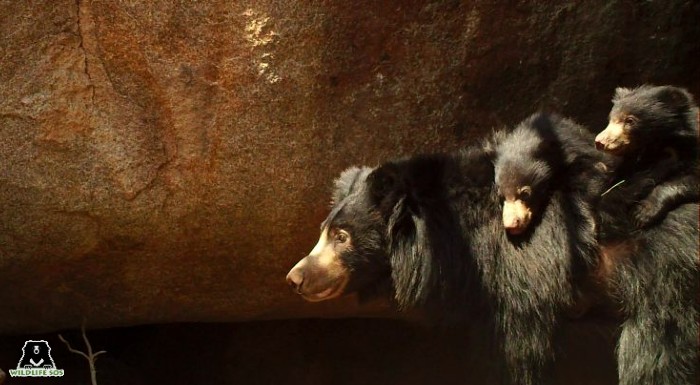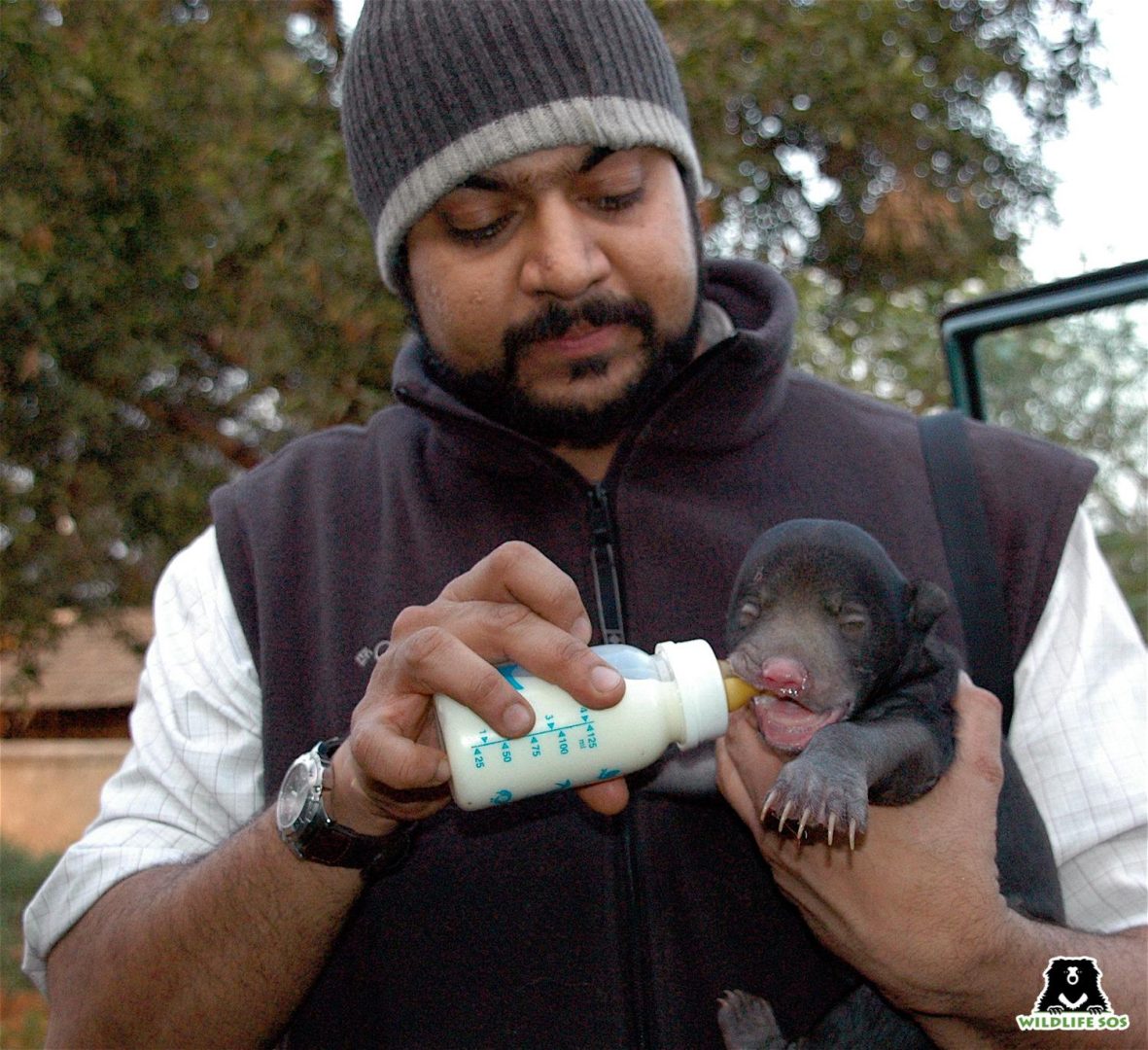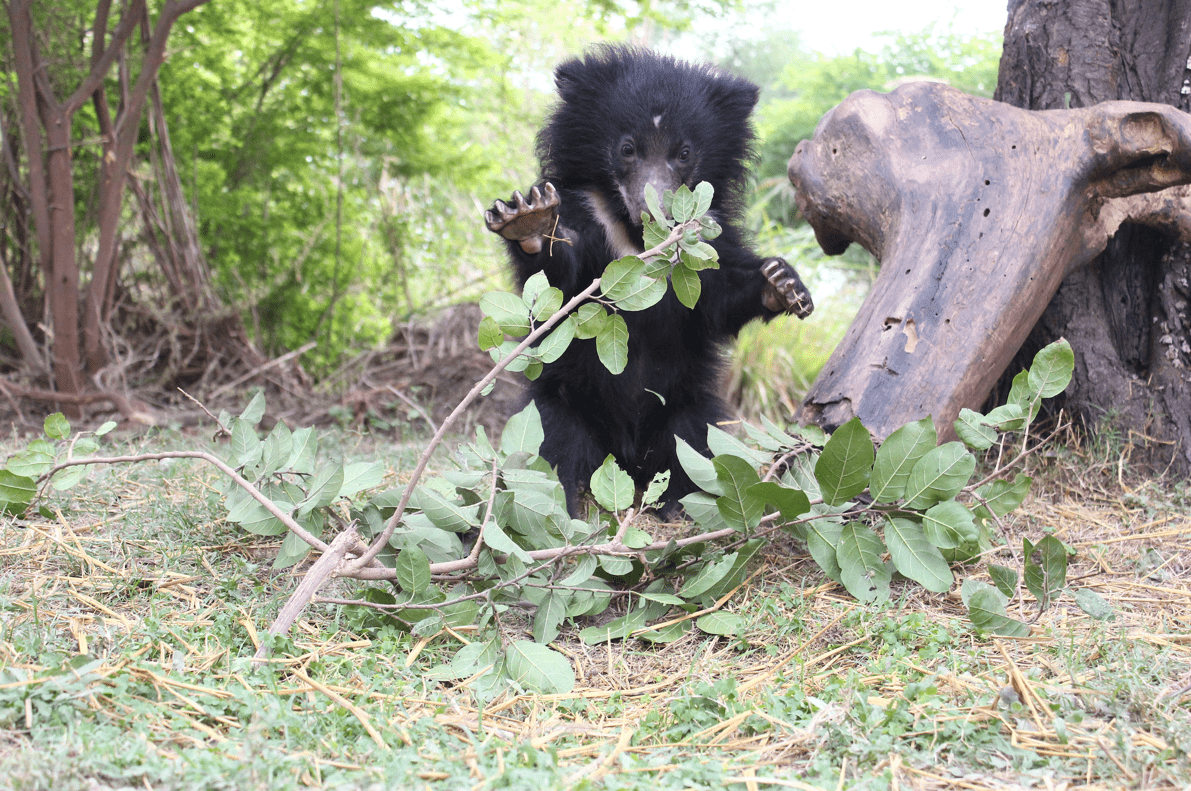In 2007, a heart-wrenching discovery at Srinagar’s Botanical Garden led the Wildlife SOS team to two abandoned Asiatic black bear cubs. Tireless efforts were made to reunite them with their mother, but all attempts were in vain. Barely a week old, the tiny cubs were vulnerable without their mother’s presence. Leaving them all by themselves would have tragically risked their lives. This was when our team stepped in to take on the responsibility of providing the two with urgent and sensitive care. Fondly named as Rozy and Fancy, the two siblings were gently hand-reared by our caregivers at the centre.
Fast forward sixteen years, and the two have now grown into mighty and healthy bears. Rozy and Fancy have thrived under dedicated care at Dachigam Rescue Centre. A vibrant and enthusiastic bear, Rozy’s persona is an exemplary result of the compassionate efforts of the Wildlife SOS team. Equally captivating is Fancy, who, like Rozy, has grown into a magnificent bear under the watchful eye of the caring staff.

In another incident that unfolded in Madhya Pradesh, a sloth bear cub was found in the Sanjay-Dubri National Park. Clinging to his dying mother, the 10-week-old cub’s survival hung by a thread. The mother, driven by the need for sustenance, ventured out of the reserve in search of food, but fell victim to high voltage wires set by poachers. Miraculously however, the cub survived this tragedy, with minor electrical burns on his forehead and back. Our team brought him under long-term care at the Agra Bear Rescue Facility (ABRF), and the sloth bear, called Mowgli, has grown up to become a strong, fit and lively seven-year-old.
These distressing stories reflect the reality faced by bear cubs in the wild. Anthropogenic pressures, such as habitat loss, deforestation, poaching and human-wildlife conflict, force these cubs and their mothers into perilous situations. Compelled by the scarcity of resources in their shrinking habitats, mother bears venture into human settlements, thereby exposing their cubs to life-threatening dangers.
Bear cubs are wholly dependent upon their mother for the first two formative years of their lives. Under her guidance, they undergo a critical period of learning essential skills to navigate the challenges of the wild. It’s the mother bear who protects them, warms them, and lovably cradles the cubs in her forelegs while nursing them. The loss of a mother not only deprives them of nurturing care, but also leaves them ill-equipped to sustain their life independently in the wild.

Over the past two decades, Wildlife SOS has undertaken a groundbreaking endeavour in hand-rearing several orphaned bears across India in its centres. These centres, namely, Agra Bear Rescue Facility, Bannerghatta Bear Rescue Centre, Van Vihar Bear Rescue Facility, Dachigam Rescue Centre, and Pahalgam Rescue Centre, have been a haven for rescued Asiatic black bears, Himalayan brown bears, and sloth bears. Holistic care to each rescued bear and bear cub is provided, with close attention to their specific needs and requirements.

For bear cubs, Wildlife SOS’s initial and paramount focus is to reunite the cubs with their mothers. Due to conflict situations that they are often found in, the chances of reunion become bleak, as mother bears often succumb to brutal snare traps laid out, or are victims of train or road accidents. The cubs are therefore found deserted, and need immediate and intensive care. Rescued baby bears require constant supervision and tender upbringing, which is given to them through delicate hand-rearing.
Neonatal Care for Bear Cubs
The neonatal period for newborn bears lasts for the first six months of their life. Based on extensive observations from the experience of safely hand-rearing cubs, Wildlife SOS has been able to standardise the care given to neonatal bears.
Veterinarians at Wildlife SOS centres devise a meticulous routine to rear bear cubs. The first phase involves a 30-day quarantine—a pivotal period that focuses on preventing any disease a cub can be susceptible to. Caregivers step into the role of surrogate mothers, and diligently monitor the cubs’ health day and night. To mirror the nurturing and gentle techniques employed by mother bears, caregivers stimulate natural defecation by frequently massaging the perianal region of the young ones. The veterinarians conduct routine check-ups, including body weight assessments and body morphometry analysis, to keep a tab on their body dimensions. These are integral to ensure appropriate growth rate and optimal food intake for the hand-reared younglings. Caregivers have noted that under ideal hand-rearing, a bear cub can experience a growth rate of 10-15 percent every 24 hours!
The Ideal Environment
Hygiene is stringently maintained in the special enclosures of bear cubs, where they gradually acclimatise to the new environment. The infant cubs are placed within a weaning room, which is kept as dark as a cave they would have been within in the wild. This precautionary measure is taken to safeguard the retinas of the cubs from any potential damage that can be caused by direct exposure to sunlight. Caregivers and veterinarians recreate a setting that resembles a natural den. This includes replicating optimal temperature and humidity levels of their natural habitat as well. For the first two weeks, this enclosure maintains an ideal temperature between 30 to 37 degrees Celsius, with humidity levels set at 60 to 70 percent. These conditions are gradually adjusted to simulate the transition from den life to the open wilderness.

Psychological Well-Being:
When we typically think of bears, we envision formidable predators, like grizzlies, evoking a sense of danger. However, Wildlife SOS with a decade of working with bears, has discovered that they possess a playful side, evident not only in cubs but also in adult bears. Cubs engage in endless play-fighting, chasing each other, and even playing footsie while lazing around. Recognizing this playful nature, Wildlife SOS has provided structural enrichments for bear cubs, including wooden logs, hammocks, water troughs, pools, and enrichment balls hanging from logs and trees. These enrichments not only promote physical exercise but also stimulate their minds, ensuring their overall well-being. Each bear cub is allocated its enclosure, spacious enough to accommodate their growth into large adults, while the enrichments are designed to mimic natural conditions in the wild, providing resources similar to those a wild bear would encounter, thus keeping them engaged and mirroring their natural habitat.
Dietary Schedule
In addition to addressing their physical needs and psychological, the veterinarians also tailor the diets of the bear cubs to meet their nutritional requirements. They are nourished with a specialised formula milk, crafted with specific ratios of dry matter, fat, protein, and sugar to mimic the essential components found in the milk of mother bears. The staff at Wildlife SOS centres make sure that the cubs regularly consume this formula, served warm, for the first three months.
The neonatal period for bear cubs is a phase of high-growth rate. During this time frame, the cubs indulge in this milk concoction up to 12 times a day, a frequency that gradually decreases as they reach the age of six months. To supplement their intake during this critical period, the cubs are also provided with 10-15 millilitres of glucose that is mixed with an electrolyte solution.
As the cubs mature and reach six-months of age, they graduate to a diet comprising mashed fruits and honey. Hereon, their dietary routine adheres to a carefully charted out feeding schedule that supports their robust growth. Their diet is further expanded to include ragi (finger millet) and wheat porridge, complemented with milk and fresh fruits. To keep the bears active and engaged, the caregivers at Wildlife SOS also provide enrichments that include dates, an added ingredient in their food intake that is served to them twice a day. Healthy half-year-old bear cubs weigh somewhere between 20 and 25 kilograms.
Medical Precautions
Addressing the probability of risks associated with rabies, tetanus, canine adenovirus, and leptospirosis, routine vaccinations are given when the bear cubs reach the age of three months. Subsequently, scheduled deworming treatments are implemented from the age of six months to secure the health of the bears.
Declining Numbers due to Human-Bear Conflict
Driven by the relentless march of urbanisation, habitat loss, and antiquated practices like the ‘dancing’ bear tradition, human-bear conflict in India has seen an upward trajectory. This clash impacts the sloth bears, Asiatic black bears, and Himalayan brown bears, pushing their populations to precarious levels. With 5,400 to 6,790 Asiatic black bears left in India, they have been classified as Vulnerable by the IUCN Red List. Less than 1,000 Himalayan brown bears are left in the world, with half of that number speculated to be in India. Sloth bears, too, find themselves in jeopardy — with a dwindling population of approximately 6,000 to 11,000 individuals, IUCN lists them as being Vulnerable as well. In the face of these harsh realities, Wildlife SOS is attempting to provide necessary intervention to save India’s bears.
Wildlife SOS is determined to care for young, injured, and orphaned bears at our centres, and we urge you to help us support their welfare by making a donation.





